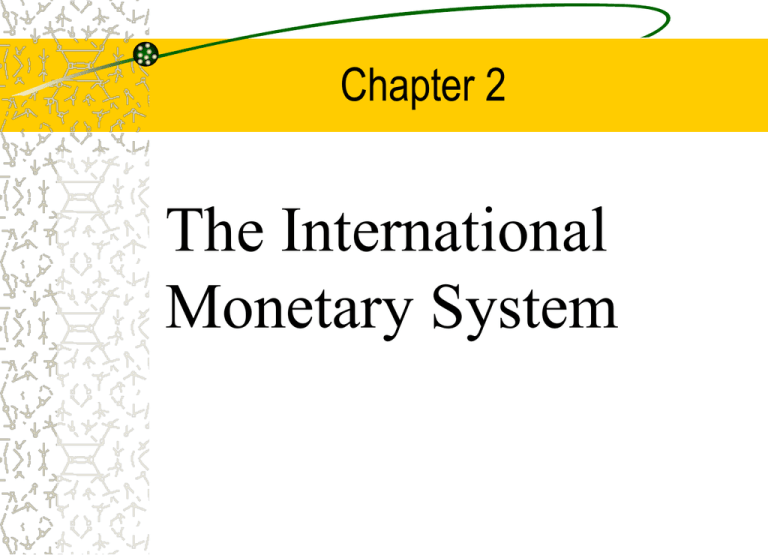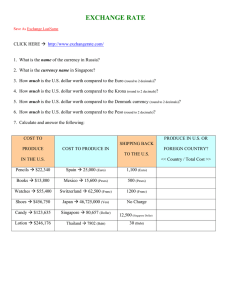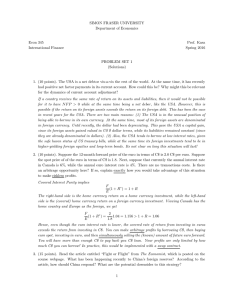The International Monetary System Chapter 2
advertisement

Chapter 2 The International Monetary System Chapter Two Outline Evolution of the International Monetary System Current Exchange Rate Arrangements European Monetary System Euro and the European Monetary Union The Mexican Peso Crisis The Asian Currency Crisis Fixed versus Flexible Exchange Rate Regimes Evolution of the International Monetary System Bimetallism: Before 1875 Classical Gold Standard: 1875-1914 Interwar Period: 1915-1944 Bretton Woods System: 1945-1972 The Flexible Exchange Rate Regime: 1973Present Bimetallism: Before 1875 A “double standard” in the sense that both gold and silver were used as money. Some countries were on the gold standard, some on the silver standard, some on both. Both gold and silver were used as international means of payment and the exchange rates among currencies were determined by either their gold or silver contents. Gresham’s Law implied that it would be the least valuable metal that would tend to circulate. Classical Gold Standard: 1875-1914 During this period in most major countries: – Gold alone was assured of unrestricted coinage – There was two-way convertibility between gold and national currencies at a stable ratio. – Gold could be freely exported or imported. The exchange rate between two country’s currencies would be determined by their relative gold contents. Classical Gold Standard: 1875-1914 For example, if the dollar is pegged to gold at U.S.$30 = 1 ounce of gold, and the British pound is pegged to gold at £6 = 1 ounce of gold, it must be the case that the exchange rate is determined by the relative gold contents: $30 = £6 $5 = £1 Classical Gold Standard: 1875-1914 Highly stable exchange rates under the classical gold standard provided an environment that was conducive to international trade and investment. Misalignment of exchange rates and international imbalances of payment were automatically corrected by the price-specie-flow mechanism. Price-Specie-Flow Mechanism Suppose Great Britain exported more to France than France imported from Great Britain. This cannot persist under a gold standard. – Net export of goods from Great Britain to France will be accompanied by a net flow of gold from France to Great Britain. – This flow of gold will lead to a lower price level in France and, at the same time, a higher price level in Britain. The resultant change in relative price levels will slow exports from Great Britain and encourage exports from France. Classical Gold Standard: 1875-1914 There are shortcomings: – The supply of newly minted gold is so restricted that the growth of world trade and investment can be hampered for the lack of sufficient monetary reserves. – Even if the world returned to a gold standard, any national government could abandon the standard. Interwar Period: 1915-1944 Exchange rates fluctuated as countries widely used “predatory” depreciations of their currencies as a means of gaining advantage in the world export market. Attempts were made to restore the gold standard, but participants lacked the political will to “follow the rules of the game”. The result for international trade and investment was profoundly detrimental. Bretton Woods System: 1945-1972 Named for a 1944 meeting of 44 nations at Bretton Woods, New Hampshire. The purpose was to design a postwar international monetary system. The goal was exchange rate stability without the gold standard. The result was the creation of the IMF and the World Bank. Bretton Woods System: 1945-1972 Under the Bretton Woods system, the U.S. dollar was pegged to gold at $35 per ounce and other currencies were pegged to the U.S. dollar. Each country was responsible for maintaining its exchange rate within ±1% of the adopted par value by buying or selling foreign reserves as necessary. The Bretton Woods system was a dollar-based gold exchange standard. Bretton Woods System: 1945-1972 British pound German mark French franc Par Value U.S. dollar Pegged at $35/oz. Gold The Flexible Exchange Rate Regime: 1973-Present. Flexible exchange rates were declared acceptable to the IMF members. – Central banks were allowed to intervene in the exchange rate markets to iron out unwarranted volatilities. Gold was abandoned as an international reserve asset. Non-oil-exporting countries and less-developed countries were given greater access to IMF funds. Current Exchange Rate Arrangements Free Float – The largest number of countries, about 48, allow market forces to determine their currency’s value. Managed Float – About 25 countries combine government intervention with market forces to set exchange rates. Pegged to another currency – Such as the U.S. dollar or euro (through franc or mark). No national currency – Some countries do not bother printing their own, they just use the U.S. dollar. For example, Ecuador, Panama, and El Salvador have dollarized. European Monetary System Eleven European countries maintain exchange rates among their currencies within narrow bands, and jointly float against outside currencies. Objectives: – To establish a zone of monetary stability in Europe. – To coordinate exchange rate policies vis-à-vis nonEuropean currencies. – To pave the way for the European Monetary Union. What Is the Euro? The euro is the single currency of the European Monetary Union which was adopted by 11 Member States on 1 January 1999. These original member states were: Belgium, Germany, Spain, France, Ireland, Italy, Luxemburg, Finland, Austria, Portugal and the Netherlands. EURO CONVERSION RATES 1 Euro is Equal to: 40.3399 BEF Belgian franc 1.95583 DEM German mark 166.386 ESP Spanish peseta 6.55957 FRF French franc .787564 IEP Irish punt 1936.27 ITL Italian lira 40.3399 LUF Luxembourg franc 2.20371 NLG Dutch gilder 13.7603 ATS Austrian schilling 200.482 PTE Portuguese escudo 5.94573 FIM Finnish markka What is the official sign of the euro? The sign for the new single currency looks like an “E” with two clearly marked, horizontal parallel lines across it. € It was inspired by the Greek letter epsilon, in reference to the cradle of European civilization and to the first letter of the word 'Europe'. What are the different denominations of the euro notes and coins ? There are be 7 euro notes and 8 euro coins. The notes are: €500, €200, €100, €50, €20, €10, and €5. The coins will be: 2 euro, 1 euro, 50 euro cent, 20 euro cent, 10, euro cent, 5 euro cent, 2 euro cent, and 1 euro cent. The euro itself is divided into 100 cents, just like the U.S. dollar. How did the euro affect contracts denominated in national currency? All insurance and other legal contracts continued in force with the substitution of amounts denominated in national currencies with their equivalents in euro. Value of the Euro in U.S. Dollars January 1999 to March 2003 The Long-Term Impact of the Euro If the euro proves successful, it will advance the political integration of Europe in a major way, eventually making a “United States of Europe” feasible. It is likely that the U.S. dollar will lose its place as the dominant world currency. The euro and the U.S. dollar will be the two major currencies. The Mexican Peso Crisis On 20 December, 1994, the Mexican government announced a plan to devalue the peso against the dollar by 14 percent. This decision changed currency trader’s expectations about the future value of the peso. They stampeded for the exits. In their rush to get out the peso fell by as much as 40 percent. The Mexican Peso Crisis The Mexican Peso crisis is unique in that it represents the first serious international financial crisis touched off by cross-border flight of portfolio capital. Two lessons emerge: – It is essential to have a multinational safety net in place to safeguard the world financial system from such crises. – An influx of foreign capital can lead to an overvaluation in the first place. The Asian Currency Crisis The Asian currency crisis turned out to be far more serious than the Mexican peso crisis in terms of the extent of the contagion and the severity of the resultant economic and social costs. Many firms with foreign currency bonds were forced into bankruptcy. The region experienced a deep, widespread recession. Currency Crisis Explanations In theory, a currency’s value mirrors the fundamental strength of its underlying economy, relative to other economies. In the long run. In the short run, currency trader’s expectations play a much more important role. In today’s environment, traders and lenders, using the most modern communications, act by fight-or-flight instincts. For example, if they expect others are about to sell Brazilian reals for U.S. dollars, they want to “get to the exits first”. Thus, fears of depreciation become self-fulfilling prophecies. Fixed versus Flexible Exchange Rate Regimes Arguments in favor of flexible exchange rates: – Easier external adjustments. – National policy autonomy. Arguments against flexible exchange rates: – Exchange rate uncertainty may hamper international trade. – No safeguards to prevent crises. Fixed versus Flexible Exchange Rate Regimes Suppose the exchange rate is $1.40/£ today. In the next slide, we see that demand for British pounds far exceed supply at this exchange rate. The U.S. experiences trade deficits. Dollar price per £ (exchange rate) Fixed versus Flexible Exchange Rate Regimes Supply (S) Demand (D) $1.40 Trade deficit S D Q of £ Flexible Exchange Rate Regimes Under a flexible exchange rate regime, the dollar will simply depreciate to $1.60/£, the price at which supply equals demand and the trade deficit disappears. Dollar price per £ (exchange rate) Fixed versus Flexible Exchange Rate Regimes Supply (S) $1.60 $1.40 Demand (D) Dollar depreciates (flexible regime) Demand (D*) D=S Q of £ Fixed versus Flexible Exchange Rate Regimes Instead, suppose the exchange rate is “fixed” at $1.40/£, and thus the imbalance between supply and demand cannot be eliminated by a price change. The government would have to shift the demand curve from D to D* – In this example this corresponds to contractionary monetary and fiscal policies. Dollar price per £ (exchange rate) Fixed versus Flexible Exchange Rate Regimes Supply (S) Contractionary policies (fixed regime) Demand (D) $1.40 Demand (D*) D* = S Q of £




